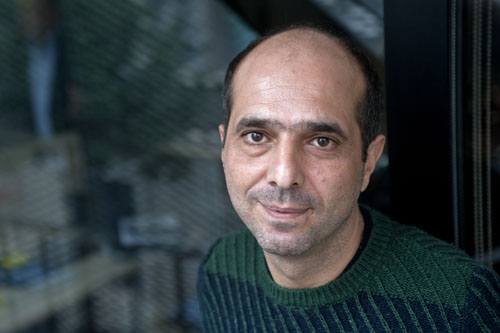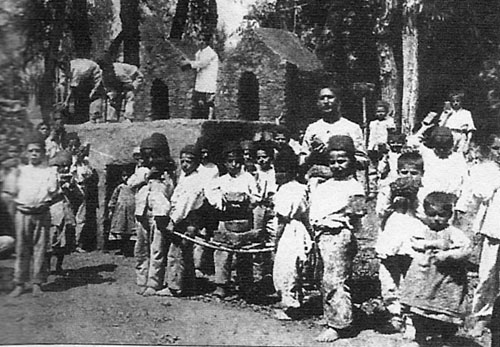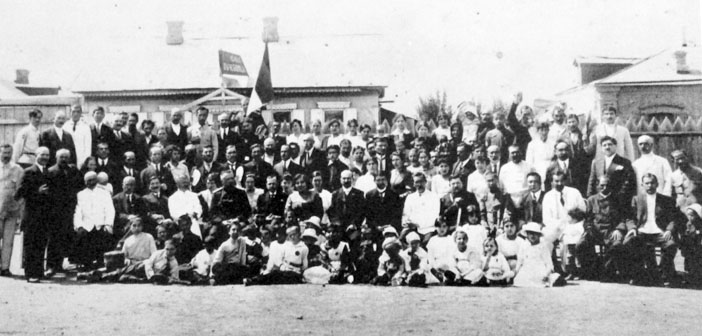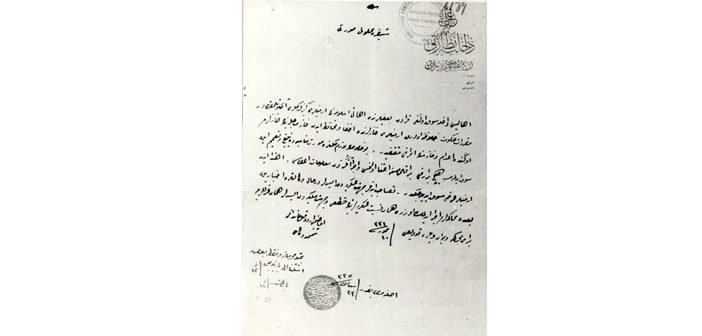“The Social, Cultural and Economic History of Van and the Region” conference organized by Hrant Dink Foundation was held in Anarad Hığutyun building on November 11 and 12. We talked to Dr. Yektan Türkyılmaz, who was the keynote speaker of the conference, about Van's importance in Armenian and Ottoman history.
Van is like a laboratory for the period between
late 19th century and 1915 and you talked about Van from
this perspective. How do you define that period of Van?
First of all, we shouldn't start with 1915. We see that Van is way more deeper than we thought. It is the center of the process that includes the establishment of a modern Armenian identity with more dimensions, the emergence of ethnic tensions in the region and the shaping of the state, society and international players. The conference showed this very clearly.
 In fact, Van is always thought in the context of
the famous resistance in 1915. However, Van became significant
starting from the late 19th century. Let's start from
there if you'd like.
In fact, Van is always thought in the context of
the famous resistance in 1915. However, Van became significant
starting from the late 19th century. Let's start from
there if you'd like.
Of course Van was very significant; the conditions that made the resistance possible are also related to it. Providing arms is not enough to direct people to resist. The perspective of resistance, the gain and the price of resistance and the chances have a historical depth. Let met put it in this way: we are going through such a period that everything we know is shattering once again. For instance, we were thinking that an international interest in the Armenian question emerged after The Russo-Turkish War of 1877–78 and an intellectual interest followed it. Today, the focus of the interest has changed. We are more interested in the constitutional law of Ottoman Armenians; we realize that Zartonk, the awakening of Armenians, cannot be limited to that history. We also see that local players and especially Van were important for Ottoman Armenians during that process. In my presentation, I named some people, let me repeat it. For instance, there were Azdvi Vaspuragan and Khrimian Hayrik. In fact, when you lookat the autobiography of Patriarch Khrimian Hayrik, you can trace the way that the Armenian identity was re-established. He was the patriarch in Istanbul and catholicos in Etchmiadzin, but Hayrik's mind was always in Van. And his thought was shaped in accordance with the stories of the Armenians in Van and his dreams about their liberation. There is an important point that we should note here: Van was never a closed area; it had many more connections than we thought. It was in contact with the local and global networks. We should also mention another person: Portukalian. He combined the idea of national liberation and education. Education was always important, but Portukalian had an important part in the process of combining the idea of national liberation and education, which led to an actual revolutionary transformation. I want to add something: I think that the awakening in Van was different from the ones in Tbilisi and Istanbul. When Portukalian established the school, he had already an idea of national liberation in mind, which was not something abstract. The first Armenian party Armenakan was established in Van in 1885 and it was not a coincidence.
I want to talk about this period. What were Armenians in Van going through during 1880s? What was the reason of this need for organization?
I think that people don't get creative only when bad things happen. Possibilities should also be considered in addition to experiences. What kind of possibilities and opportunities do you have? Which networks are available? We think of Van as the eastern province (vilayet) of Ottoman Empire, but it is not the whole truth. In my presentation, I used the name “Vaspuragan”. It is the capital of the kingdom which is the symbol of the golden age in national Armenian narration. I just wanted to point to a spatial system. As a geographical unit, Vaspuragan covers a region from Hizan to Hoy and from Amidiye (northern Iraq) to Nakhchivan. What does it mean? Van is more than the easternmost city of Ottoman Empire; it is a part of the system that connects three empires. We cannot understand what happened in Van without understanding what happened within that system. And this spatial network was not important just for Armenians. For instance, think about Kurds and proto-Kurdish-nationalists. Think about Simko Shikak, Abdurrezzak Bedirhan and Huseyin Pasha of Haydaran. All of these people were parts of this network. In fact, this network provided a lot of opportunities, so it remained. I mean, you shouldn't think that the borders were determined by Treaty of Zuhab in 1639. The relations went on with ashiret ties and smuggling. Revolutionary activities kept this relationship alive. So, what happened there? The former order was disturbed by Ottoman modernization and chaos emerged. There was chaos and problems caused by Ottoman centralization on the one hand and there were increasing opportunities on the other hand. It was a productive chaos, just like any chaos. Emre Can Dağlıoğlu also made a presentation in this conference and we learn that there was an Armenian Catholicos in Akhtamar, whose parents were Syriacs, and his closest allies were Kurdish ashirets. Majority of Armenians were disturbed by this. What I am trying to say is that players were engaged in complicated relationships and the oppression was increasing. And the state was going through a similar process: players from different circles were imposing their projects, while they were transforming themselves. There was a disturbance in land and property ownership. And we see that the problems of Armenian villagers became overwhelming. Interestingly, Armenian resistance movements in that period are generally ignored; for instance, there was defense of Van Fortress in 1862. We began to see and understand such events. There is another ecclesiastic from Zartonk Van that I want to mention: Srvandztiants. His activities were similar to those of Komitas. It was also a turning point for ecclesiastics. He collected folk tales and he brought into light a version of the Armenian national epic “Daredevils of Sassoun”. What is the main theme of this epic? The victory of a righteous minority group against the enemy. I think that this indicates the mood of that period very well. For instance, Raffi was also a prominent figure in Zartonk. He was also a player in that Vaspuragan network. We see that Van had discovered people long before people discovered it. Tbilisi discovered Van after 1878. People discovered Historical Hayastan and Van was the center of this interest. You can see it in the literature created in that period. You can check Azkakragan Hantes out, for instance. The interest in Van was incomparably great.
Van was also a place where modern political movements like nationalism and socialism emerged. I mean, for Armenians. Right?
Right. When we study on Van, we see the larger story. There was a tradition peculiar to Van province: Armenakan. It wasn't formed by chance. It was inspired by Portukalian's national liberation idea; it was a liberal nationalist tradition, which became somewhat conservationist later. The distinctive characteristic of Van is Armenak tradition; a liberal nationalist organization advocating for armed struggle for liberation. We had always thought that Ottoman Armenia was like a passive recipient of Zartonk. Van even went beyond it; you see its creativity in the creation of Armenakan, which was something unprecedented. We know about the 1896 resistance in Van, but there was another resistance movement in 1889 in Başkale, which was organized by Armenakan. We should note that we ignored the history that made 1915 what it is. 1896 was a very important turning point. 1896 shows us the fact that violence is a constituent element. Let me explain what was shattered in Van in 1896. In the second half of 19th century, Van started to flourish. There were textile, leather and furniture shops everywhere. Silver and goldsmiths were very improving. At the beginning of 20th century, there were 1,500 workers, proletariat as we know. Thus, the first strikes were meant to happen in Van. However, 1896 wiped this development off; it was like a death blow to the accumulation that was created by Armenian enrichment. It incited a new process in terms of identity. Furthermore, many places in Van was destroyed; some of the destroyed neighborhoods had never been rebuilt. Aykestan, the actual Armenian neighborhood, was always there, but it was seen like a safe place. The fact that Armenian neighborhoods were strategically defensible made 1915 resistance possible. In terms of identity, 1896 was transition from a group defined by religion to a national identity, though it was imperfect.
 Let's talk about 1915. In the official history,
the Defense of Van has been considered as the reason of the
deportation. They say, “They deserve it.” What was the real
situation?
Let's talk about 1915. In the official history,
the Defense of Van has been considered as the reason of the
deportation. They say, “They deserve it.” What was the real
situation?
By the end of 1914, Armenian society was more separated than ever before. This is the group that is accused of conspiracy and rebellion. Let's start from here. Armenians had turned against each other. In 1908, there was not one but two revolutions for Ottoman Armenians: (1) Young Turks' defiance to Abdulhamid II in Istanbul and (2) a radical transformation process marked by the removal of Patriarch Malachia Ormanian. It was the last phase of the process that started with the “Regulation of the Armenian Nation” (Nizâmnâme-i Millet-i Ermeniyân) in 1860s: the final move of the revolutionaries in order to remove the patriarchate as the only representative of the Armenians in the face of the state. Center of power had shifted from Kumkapı to Pera, where the offices of the parties were located. And in Van, there was Tebi Yergir (back to the Interior, i.e., the eastern provinces) movement in addition to Armenekan. This means that other movements started to take root in Van; Hnchakyan Party and Dashnaktsutyun were also there. They also played a part in 1896. However, in 1908, something happened that concerned Dashnaktsutyun. Just before 1908, there was the treason of Tavo, which is very infamous. The reasons for treason should be discussed. Some people say that there was a sad love story behind it, we don't know for sure. Tavo gave away the location of weapons and ammunition and names of the party members, and Dashnaktsutyun received a major blow. Every one was jailed, including Aram Manukian. By a twist of luck, these people emerged from the prison as the heroes of the revolution. Dashnaktsutyun came to have an important role in decision making concerning the province. In short, in 1908-1914, Dashnaktsutyun was very influential in Van. They used their alliance with the Unionists very wisely. However, Dashnaktsutyun used its power against other Armenian groups. They acted very aggressively. Unionists supported them, especially in their actions against the church. There were lots of political assassinations; majority of them were perpetrated by Dashnaktsutyun against liberal nationalists. These actions went unpunished, since the authorities turned a blind eye to the attacks against the liberal nationalist Armenians. And no one dared to file complaints. Such developments led to separation within the society. In 1914, Armenian society was really separated. We should also note that 1914 was a happy year for Van. Can you imagine? There had been struggle for reform from 1878 to 1914. It finally happened and a European inspector called Hoff was in Van. Also, there was a group of Unionists. They were still allies with Dashnaktsutyun, though there was resentment, since there was a more powerful player now.
This sounds really familiar, but let's not go there now.
It is familiar indeed, but we have just started to see things from this perspective. On June 1914, Armenians of Van were hopeful than ever before. A hopeful but separated group. And all of a sudden, a war erupted. Let me say this first: Van was the epicenter of the earthquake of genocide. What does it mean? From the optimism to the emergence of tension and finally to the collapse, Van was like the barometer of that period.
What happened in Van? How did it start?
Let me say something very shocking. After the war erupted, Dashnaktsutyun leader Aram Manukian wandered around the Armenian neighborhoods and urged the young Armenians to join the army. People were reluctant. And the real shock is: especially young Armenians from Dashnaktsutyun party joined the army in order to encourage other Armenians. Later, Armenians in Van, justifiably, blamed the members of Dashnaktsutyun; they shouldn't have been so blind. Governor of Van Tahsin Bey said, “Armenians in Van don't cause problems. On the contrary, they are helping us.” The central government was seeking for reasons to escalate the tension, but the governor was speaking on the contrary. We should note that Armenians meant Dashnaktsutyun for the government back then, since the other institutions were so meaningless. When everything was just fine, an incident took place near Timar. Gendarme forces and İnknabashdbanutyun (self-defense) clashed. There was a Russian invasion and after Russian forces retreated on November and December, a massacre was committed. I want to add something. On November, Muslims were really worried, since there was no security forces left in Van. At the same time, Dashnaktsutyun was organized and armed, Ramkavar had certain power. Later, many Armenians in Van wrote in their memoirs that it was the best time for rebellion, since you didn't even need to rebel. However, nobody was thinking about rebellion! Then, Cevdet was assigned as the governor. I doubt that the situation would have been different, if Tahsin were still in office. Cevdet had paranoid thoughts like, “Armenians in Van will rebel.” He was thinking that they would make the all Armenians pay the price, if it happens. There was no rebellion in Van; there was the conspiracy of Cevdet and a people who was fighting for their lives. Just like the state calls the incidents in Dersim “rebellion”.
What happened in 1915 during that turning point?
First, some incidents took place in Şatak, which started with a detention of a teacher. According to some accounts, he was fighting in the war and he came back after he got wounded. It is so complicated. Then, Cevdet talked to İşhan, who was in charge of military activities of Dashnaktsutyun and said, “Go there and make things right.” İşhan was thinking that he will go there to make things right. However, this is not what happened. He was ambushed and killed, and then Van Deputy Vramian was arrested (who also was killed later). Governor of Van claimed responsibility for all these incident. He said, “This state won't be a putty in the hands of a couple of young Armenians.” Dashnaktsutyun, which was supposed to be powerful, were paralyzed after that. They were really unprepared. Some sources claim that they had been getting ready for months, but it is not true. Thus, the Defense of Van was led by someone from Armenakan tradition, a Ramkavar called Armenak Egarian. How did it come to the Defense? Let me explain. After the incidents that I mentioned took place, prominent figures of the city met with the governor for negotiating. However, the government, which lost in Iran, hit by Russia and lost in Sarıkamış, was willing to make someone pay the price. Cevdet clearly said that there won't be any negotiation, they lost the contact with the state. He said, “You are more than a society now”. He was willing to annihilate them. That is why I say that the genocidal intent was seen in Van for the first time in Ottoman territory. Armenians had 1,000 armed fighters and they started ditching a few days before the clashes, which started on April 19. On the other hand, Ottomans had Kurdish militia. Interestingly, Muslim locals of Van hadn't joined this militia forces. Armenians had already released a statement saying that they had nothing to do with the Muslim locals of Van. So, Defense of Van wasn't the cause of some incidents, it was the effect. However, the government used it as an excuse for making the Armenians look like the enemies inside. The Defense was amazing. Like I said, the Armenian society in Van was really separated, but then a moment came and there was no separation anymore. By the way, there were clashes not only in the city of Van but in the entire province of Van. The people running away from the massacres elsewhere were coming to Aykestan. And the state let them, since they thought that Armenians will exhaust their resources in this way. However, Armenians in Van overcame it thanks to an amazing solidarity. You can talk about it for a hundred years, which is exactly what Armenians in Van did. Class discrimination and other reasons for separation were forgotten and a real commune emerged. There was a great resistance and defense. Fortunately, Cevdet retreated after Russian and Armenian forces won in Dilman. After the retreat, Armenians took the city. However, they lost unity afterwards. What happened next is very complicated.
We should schedule another interview for talking about it. The process leading to the defense is enough for now.
There is an interesting point. Van is neither a hero nor a veteran in the narration of Turkish nationalism. Kurdish narration also doesn't care about Van. However, when I was in Armenia, I realized that everything is Van Vaspuragan for them. Armenians of Van are Armenian of course, but they are Vanetsi above all.





